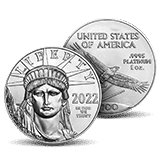
What Does Cameo Mean?
Have you seen the term Cameo printed on coin holders and used in descriptions of coins? In coin grading, cameo is the word used to describe the level of contrast between the relief and field of a coin.
What is the Difference Between Proof and Cameo Coins?
You will most frequently see Cameo referred to on Proof coins but not all Proof coins will qualify for the Cameo designation. Often, frosting in designs and in lettering is accomplished by sandblasting a die and polishing the field. Since dies are used to create numerous coins, the ability to produce the cameo effect can fade.
Cameo Designations by Organization
Do the coin-grading organizations use the same terms and have the same standards for Cameo grading?
NGC Cameo Designations
The Numismatic Guaranty Company uses Cameo and Ultra Cameo designations in grading the varying degrees of frost on the design. These terms will follow the numerical grade on the Sheldon scale that the coin receives.
Ultra Cameo is superior to Cameo, while Cameo is superior to a lack of designation. If a coin exhibits little to no frost on the design element, no designation is used. NGC applies the Cameo and Ultra Cameo designations to coins that qualify at no additional cost. The coin must demonstrate the frosted finish on the obverse and reverse of the coin to receive the Cameo designation.
PCGS Cameo Designations
The Professional Coin Grading Service employs four classes within their designation system to describe the contrast and frost on Proof coin, from Prooflike to DCAM.
Prooflike (PL)
Coins with a Sheldon score of MS-60 or higher that demonstrate clear reflectivity or mirrored surfaces at 4 to 6 inches are eligible for the Prooflike designation. If the cartwheel effect or striations prevent an area of the coin from reflecting with clarity, the coin will not be eligible for a Prooflike designation.
The term cartwheel effect is used to describe a rotating, windmill effect that some Mint State coins display. The striking process leaves flow lines on coins. These lines cause the cartwheel effect from light reflecting off the surface and the effect disappears in circulation.
Deep Mirror Prooflike (DMPL)
The Deep Mirror Prooflike designation is used for Morgan Silver Dollars with a Sheldon score of MS-60 or greater and exhibit deep reflectivity. The distinction between Prooflike and Deep Mirror Prooflike is one of degree.
Cameo (CAM)
Cameo is used for brilliant Proof coins. These must demonstrate light to moderate frosting on the devices of the coin and the frosting must be present on the obverse and reverse of the coin.
Deep Cameo (DCAM)
Brilliant Proofs that show deep and even frosting on the devices can earn the Deep Cameo designation. Like the Cameo designation, the frosting and mirror like finish must be on both sides of the coin.




